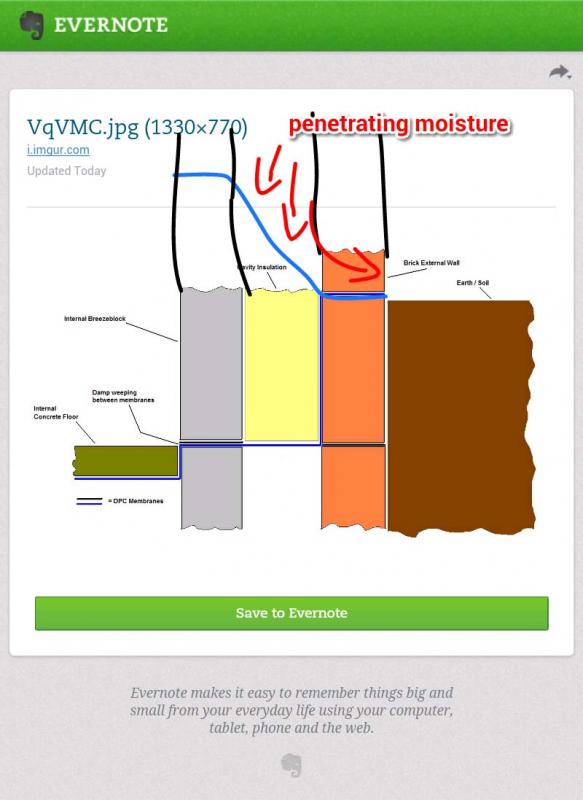Thanks again guys for your input and advice,
Oldun, I think I should probably have shown the concrete floor insulation between the floor DPC and the concrete, so that's my fault for missing it off the original drawing rather than it being missed during the build. I was concentrating on showing the wall detail rather than the floor, so apologies.
The rock-wool you use seems to look very similar to the stuff used on my build. I'm not sure what that proves, but I thought it might be of interest.
As an aside, I had a morning outside doing some remedial work to see if I can help alleviate this issue, and I've dug away everything externally in the corners and around the DPC level, so there was some earth to move there that might have been causing issues.
I also had a poke about through the air-brick and can actually feel rock-wool on the other side of the vent-holes, which was a bit of a concern. What I'm wondering is that if this air-vent is sucking cold air into the cavity area and 'through' the cavity into the 100mm vent pipe fixed into the internal wall, and 'if' this rock-wool area is in an area open to an adjacent side of this DPC sheet 'envelope', then what would be to stop cold air condensing in this area and dropping down through the rock-wool into the bottom of the DPC envelope, and then making it's way into the building ? Is this a possibility ?
I have now plugged all the air-vent holes with pipe-lagging foam cut into square strips, and I've ally-taped over the air-vent brick as well, for a belt-and-braces aim of stopping air-flow through this air-brick, to see if the moisture issue abates over Christmas. There is still another air-brick on the opposite side of the extension, feeding air into the same under-floor area, so I don't think I'm doing anything un-towards with regards to stopping 'required' air-flow for a bit, whilst I monitor things for a time.
Obviously the sensible thing to do in terms of fixing this issue for good will be to get in around the outside DPC area and remove enough bricks to get in with a sharp knife or scissors and slit the DPC membrane so as to completely remove the DPC bridge across the cavity, and this is something I'll look to do in the longer-term.
I feel that, given the two remedial actions I took this morning with regard to clearing the corner and DPC areas and also blocking the air-vent, that I should really wait to see if either of these actions helps with the moisture issue, if only to show what might have been actually causing the moisture in the first place, if it does get better. I feel that if I got in now to cut the DPC, I'd not really be any the wiser just what's causing it to get in there, so given the relatively small amount of moisture that we're talking about, and it's localised nature, that I can afford to wait and see if I can stop the moisture first, and 'then' get in later to remove the bridge in case of any future issues. I think this would be the sensible way to proceed, but I'd appreciate your thoughts on that ?
I'm also wondering, given that a covered air-brick isn't the best thing in terms of building-health, if it might be worth thinking about removing the air-brick at some point next year and creating a 'funnel' between the cavity-side of the air-brick and the 100mm vent-pipe fixed into the internal wall. I'd hope that this would then stop any outside air getting into this particular cavity, where it's not required, and only allowing it into the house under-floor area, where it's installed to feed air to. I'd hope that this would allow the vent to be used, but remove the chance of the rock-wool becoming moist with condensation, and perhaps allowing any moisture down into this cavity. Again, your thoughts would be very much appreciated on this.
In terms of creating another DPC layer above this area, with it constructed in a manner to take moisture 'away' to the external wall, I'm a little confused as to just what this might achieve ? If the moisture was getting in from the area above, I'd agree that it would be a good idea, but it seems like a lot of building work to put something in that might not particularly solve my issue, as we're still not really sure where the moisture is coming from, with the only thing we do know being that it's appearing at the bottom of the DPC 'trough' and making it's way inside the building. If the issue is lower down, where we think it might be at the moment, then wouldn't this upper DPC be a little redundant, and still leave this particular issue if we can't find a way to remedy it ?
Thanks again for all the input and time taken for the replies. This seems like a long post, but I do want to understand the issues here, and I'm trying to go into detail where I'm not 100% clear on just what we're talking about.
Cheers,
Isitwinteralready



